Banana fruit Nutrition facts
Enjoy banana fruit is nature's energy-rich food that comes with a safety envelope! Fresh, creamy, and delicious dessert bananas are one of the cheapest and readily available fruits all year round.
Botanically, it belongs to the family of Musaceae. Commercially, it is one of the widely cultivated crops in the tropical and subtropical zones. Scientific name: Musa acuminata colla.
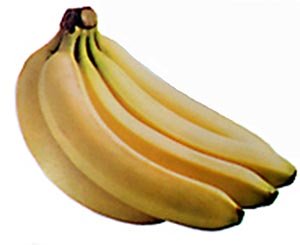 |
| Banana (Musa acuminata colla). |
Banana is a perennial herbaceous plant that grows from the underground rhizome. It flourishes well under tropical, moisture-rich, humid, low-lying farmlands.
Banana has a unique growth characteristic. In fact, the whole plant is a false stem (pseudostem). This pseudostem is consisting of broad leaves with long petioles, overlapping one another in a disc-like fashion.
The whole plant may reach 2 to 6 meters in height depending on the cultivar type. At maturity, the rhizome gives rise to a flower (inflorescence) which is carried up all along the actual (true) core stem (smooth un-branched stem), passing through the center of the pseudostem. The flower finally emerges out atop in-between leaf clusters.
The inflorescence subsequently develops into a large hanging bunch, consisting of 3 to 20 hands (tiers of fruit), with each hand carrying at least 5-10 fingers (banana fruits).
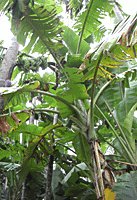
|
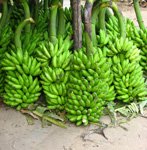
|
| Banana plant. | Raw mature banana,for sale in a market. Photo: tanbis19 |
There exist several cultivars of bananas that come in different sizes (4-9 inches), colors (yellow to brown), weights (70-150g), and tastes. Cavendish is the most common cultivar type among bananas globally. Structurally, it has a protective outer skin layer enveloping delicious, sweet-tart, cream-white edible flesh.
Plantains are other cultivar types; often recognized as cooking bananas. They are intimately related to natural fruit (dessert) bananas. Plantains are employed as a staple food in many parts of tropical African and Caribbean regions as well as in Thailand, Laos, and other Southeast Asian parts.
8 Amazing Health Benefits of Banana Fruit
Banana is one of the high-calorie tropical fruits. 100 grams of its flesh carries 90 calories. Nonetheless, it is packed with numerous health-benefiting phytonutrients like dietary fiber, anti-oxidants, minerals, and vitamins.
The banana is packed with easily digestible, soft flesh thatis rich in simple sugars like fructose and sucrose. When you eat one, its quick energy boost that instantly refreshes your body. That is why athletes love it as a go-to snack for that instant energy kick. It is also a good choice as a dietary supplement for treating undernourished children.
The fruit holds a good amount of soluble dietary fiber (7% of DRA per 100 grams) that helps in regular bowel movements, thereby reducing constipation problems.
It contains health-promoting flavonoid poly-phenolic antioxidants such as lutein, zeaxanthin, a, and ß-carotenes albeit, in small amounts. Together, these compounds help act as protective scavengers against oxygen-derived free radicals and reactive oxygen species (ROS) that play a role in aging and various disease processes.
Banana is a good source of vitamin B6 (pyridoxine) and provides about 28% of the daily recommended allowance. Pyridoxine is an essential B-complex vitamin that has a beneficial role in the treatment of neuritis, and anemia. Further, it helps decrease homocysteine (one of the triggering factors in coronary artery disease (CHD) and stroke episodes) levels within the human body.
The fruit is also an ideal source of vitamin-C (about 8.7 mg per 100g). Consumption of foods rich in vitamin C helps the body develop resistance against infectious agents and scavenge harmful oxygen-free radicals.
Fresh bananas provide adequate levels of minerals like copper, magnesium, and manganese. Magnesium is essential for bone strengthening and has a cardiac-protective role as well. Manganese is utilized as a co-factor for the antioxidant enzyme, superoxide dismutase. Copper is an essential trace element in the production of red blood cells.
Fresh banana is a very rich source of potassium. 100 g of fruit provides 358 mg of potassium. Potassium is an important component of cells and body fluids that helps control heart rate and blood pressure, countering the harmful effects of sodium.
Please visit this page to view the infographic featuring banana fruit nutrition facts per 100g: Banana fruit infographic.
| Principle | Nutrient Value | Percent of RDA |
|---|---|---|
| Energy | 89 Kcal | 4.5% |
| Carbohydrates | 22.84 g | 18% |
| Protein | 1.09g | 2% |
| Total Fat | 0.33 g | 1% |
| Cholesterol | 0 mg | 0% |
| Dietary Fiber | 2.60 g | 7% |
| Vitamins | ||
| Folates | 20 µg | 5% |
| Niacin | 0.665 mg | 4% |
| Pantothenic acid | 0.334 mg | 7% |
| Pyridoxine | 0.367 mg | 28% |
| Riboflavin | 0.073 mg | 5% |
| Thiamin | 0.031 mg | 2% |
| Vitamin A | 64 IU | 2% |
| Vitamin C | 8.7 mg | 15% |
| Vitamin E | 0.10 mg | 1% |
| Vitamin K | 0.5 µg | 1% |
| Electrolytes | ||
| Sodium | 1 mg | 0% |
| Potassium | 358 mg | 8% |
| Minerals | ||
| Calcium | 5 mg | 0.5% |
| Copper | 0.078 mg | 8% |
| Iron | 0.26 mg | 2% |
| Magnesium | 27 mg | 7% |
| Manganese | 0.270 mg | 13% |
| Phosphorus | 22 mg | 3% |
| Selenium | 1.0 µg | 2% |
| Zinc | 0.15 mg | 1% |
| Phyto-nutrients | ||
| Carotene-alpha | 25 µg | -- |
| Carotene-beta | 26 µg | -- |
| Lutein-zeaxanthin | 22 µg | -- |
Selection and storage
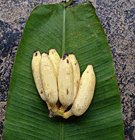
|
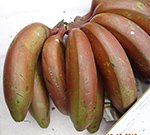
|
| A dessert banana variety on a plantain leaf. | A desert red-banana (kappa pazham) variety. |
Once ripened, bananas are very fragile fruits, that start decaying in a short span of time. In the farms, only mature, firm, and green bananas are harvested for fruiting. This practice allows farmers for easier handling and transportation.
To ripen, they are usually subjected to ethylene spray or kept in proximity to other ripe fruits.
Ready-to-eat bananas should be bright yellow, and emanate rich fruity aroma. The ripe banana peels off easily. Ripe, fresh fruits are nutritionally enriched and sweeter in taste than unripe, raw green ones. Fruit enzymes in ripe bananas make them sweeter, easily digestible, and more bioavailability of their vitamins and minerals. Less-ripe bananas can be tangy, and chewy, but can cause stomach ache and indigestion if consumed in excess amounts.
In the stores, choose banana fruits based on when you want to eat them; greener ones should last for more days, while yellow and brown-spotted bananas should be eaten within a few days.
Avoid mushy or damaged bananas, as they are unappealing.
Preparation and Serving methods
Bananas come with nature's gifted protective outer peel, and therefore, are less likely to be contaminated by germs and dust.
Eat banana fruit as it is without any additions. Just discard its peel and enjoy!
Banana fruit sections are a great addition to fruit salads.
Fresh "banana milkshake" with sugar syrup is a refreshing drink.
Bananas have also been used to prepare fruit jams.
Grilled banana fruit can be served with cake/ ice cream in the Caribbean-style dessert.
Banana chips (plantain) enjoyed as a snack (produced from dehydrated or fried banana or plantain slices).
Ripe, mashed dessert bananas make excellent cakes, casseroles, muffins, bread, pudding, etc.
Plantains and raw unripe banana can be employed as a vegetable in recipes.
Safety profile
Banana fruit consumption may result in the skin as well as systemic allergic reactions in a few sensitive persons. The condition of "oral allergy syndrome" in which symptoms may include itching and swelling around the mouth or throat within hours after ingestion. The condition may be related to cross-hypersensitivity reactions to the birch tree and other pollens.
The other type of allergic reaction is related to latex. The symptoms may include urticaria and sometimes potentially severe gastrointestinal symptoms like nausea, vomiting, and diarrhea. (Medical disclaimer).
Also read ≺≺-
≻≻- Plantains nutrition facts
≻≻-Back to Fruits from Banana Fruit. Visit here for an impressive list of all varieties of fruits with complete illustrations of their nutrition facts and health benefits.
≻≻-Back to Home page.
Further resources:
Musa species-Banana and plantains.
USDA National Nutrient Database. (opens new window)
Stanford School of Medicine Cancer information Page- Nutrition to Reduce Cancer Risk (Link opens in new window).